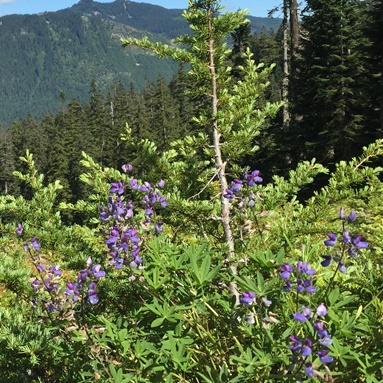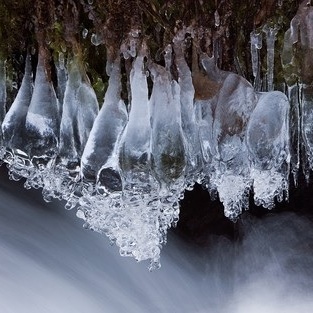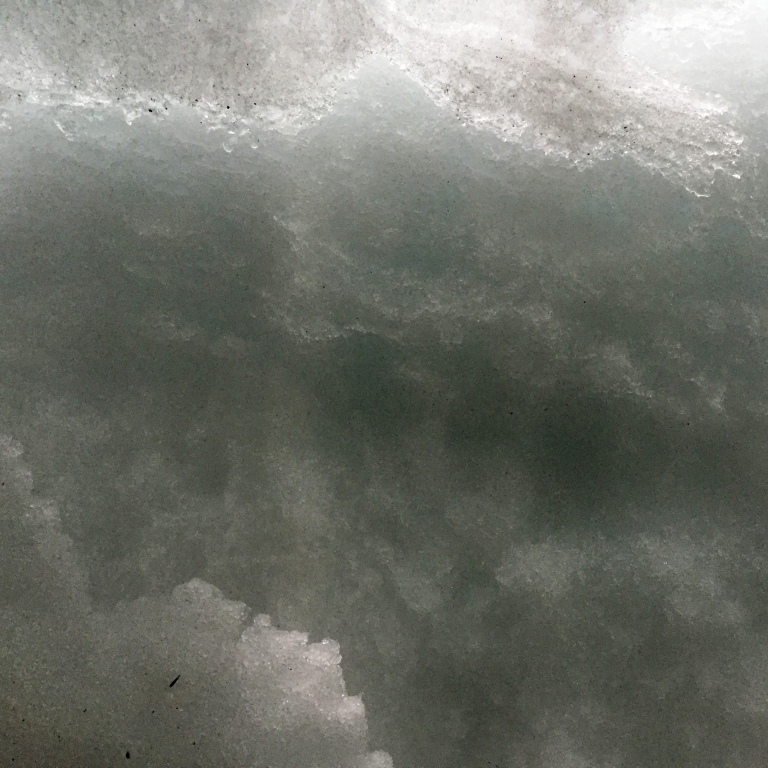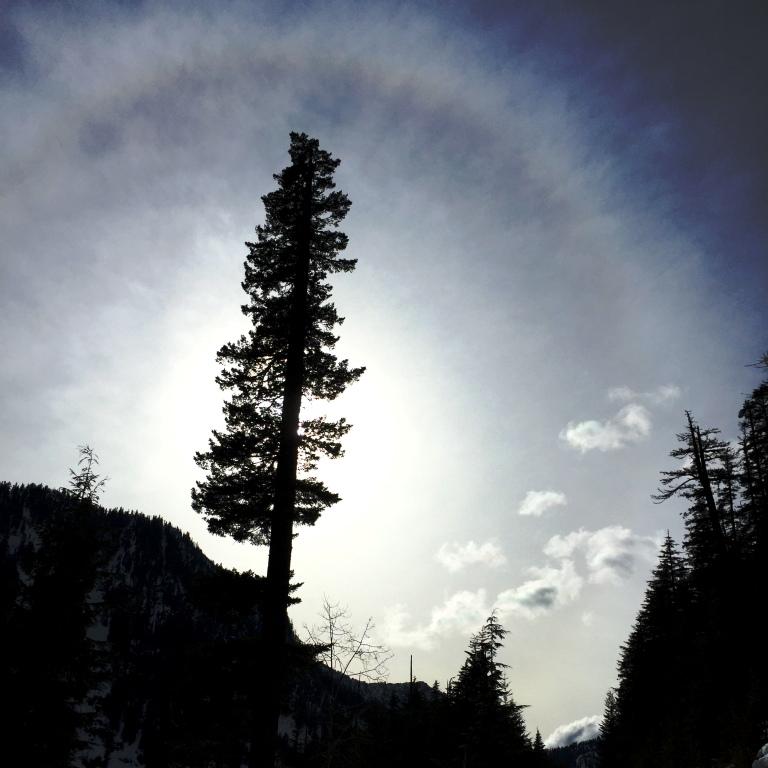Working with Baritone Guitar, Finger Piano, Marimba, Vibes on the rhythm part. I hope to add some woodwinds later on. I’m searching for a way to turn more of my musical choices into Markov Chain Drunkard Walks, but without too much of a feeling of randomness. The title is from a favorite wildflower in the Cascades, and my recent listenings to Faulkner’s Sound and the Fury while I climb the peaks up here. I’m on my third time around, hoping it will make more sense as I go through it again.

or download here:
Lupin – Like Trees #2
Blog
Lupine – Like Trees #1
Just noodling around at this point. Still not sure the titles, or the concept. Bear with me.
or download here:
Lupin – Like Trees #1
Podcast Memory Lane – ten years on
Here are two podcasts I put together for a “Make Microtonal Music Day” in 2006. They consist of a reading by Harry Partch, and then me talking about some music, and playing it. Pretty simple stuff, but still my favorite pieces of the day.
or download here:
Make Micro Music Day 2006 Part 1
Liner notes
or download here:
Make Micro Music Day 2006 Part 2
Liner notes
Icicle Creek #5
This one is just about finished. I’m checking the balance and tempo, and looking for a nice set of changes for the bridge. For some reason, all the recent runs through the algorithm have been primarily Otonality keys. Here’s what it picked for this version #5.
chorus Fn-Maj
bridge Ab-Maj Cn-Maj Eb-min Db-min
chorus Fn-Maj
bridge D+-Maj Fn-Maj Ab-Maj Cn-Maj
chorus Fn-Maj
bridge Ab-Maj Cn-Maj Eb-min Db-min
chorus Fn-Maj
bridge D+-Maj A+-Maj F+-Maj A+-Maj
chorus Fn-Maj
bridge D+-Maj Fn-Maj Ab-Maj Fn-Maj
chorus Fn-Maj
bridge Ab-Maj Fn-Maj Ab-Maj Fn-Maj
chorus Fn-Maj
The chorus is hard coded in F Major, but the rest follow a drunkard’s walk through this list of possible keys:
Cn maj
Ab maj
Fn maj
D+ maj
A+ maj
F+ maj
E- maj
Db maj
Fn min
A- min
Cn min
D+ min
Gn min
B- min
Db min
Eb min
I changed the name from Icicle River, which is a real place in the Cascades, to Icicle Creek, more of a generic term for the creeks around where I live, where there are lots of icicles every morning that melt in the hot air coming up from Seattle by noon.
or download here:
Icicle Creek #5
Icicle River #2
Added a flute part and finger piano duplicate to the guitar. Still only in the key of F major. I plan to add some subminor and super major modes later.
or download here:
Icicle River #2
Icicle River #1
I’m just starting out on this one. It’s currently scored for baritone guitar and bass finger piano. I may add some alto flute or some percussion later. Just a taste for now.
It’s in F major otonality with lots of slides with vibrato. Imagine how a slide guitar would sound if it had different slides on every note that could go up or down independently accurately to any note 72-EDO.
I live in the Cascades of Washington State, in a pass along Interstate 90, about 50 miles from Icicle River, as the high altitude crow flies. At higher elevations, the creeks are loaded with icicles this time of year, especially when a cold front comes down from Canada.

or download here:
Icicle River #1
Slow Avalanche #8
 Here is a final version of the piece. Now scored for French horn, tuba, tenor trombone, alto flute, flute, oboe, clarinet, and bassoon. It’s a Markov Chain Drunkard’s Walk through the tonality diamond. The randomizer is free to chose any chord, but only if it adjacent to the current chord. Like a drunk who can go left or right, but not stay in place and not move more than one step at a time. I exercise control by selecting a list whose elements flow from one to another and sound intelligent. Here are the choices for the chords:
Here is a final version of the piece. Now scored for French horn, tuba, tenor trombone, alto flute, flute, oboe, clarinet, and bassoon. It’s a Markov Chain Drunkard’s Walk through the tonality diamond. The randomizer is free to chose any chord, but only if it adjacent to the current chord. Like a drunk who can go left or right, but not stay in place and not move more than one step at a time. I exercise control by selecting a list whose elements flow from one to another and sound intelligent. Here are the choices for the chords:
.chor-x-01 &Cnmajx.
.chor-x-02 &Abmajx.
.chor-x-03 &Fnmajx.
.chor-x-04 &D+majx.
.chor-x-05 &A+majx.
.chor-x-06 &F+majx.
.chor-x-07 &E-majx.
.chor-x-08 &Dbmajx.
.chor-x-09 &Fnminx.
.chor-x-10 &A-minx.
.chor-x-11 &Cnminx.
.chor-x-12 &D+minx.
.chor-x-13 &Gnminx.
.chor-x-14 &B-minx.
.chor-x-15 &Dbminx.
.chor-x-16 &Ebminx.
The preprocessor has a choice to either stay for several measures on the same chord, or change chord each measure. The Chorus stays in place for eight measures. The bridge changes every measure. Here is what was chosen in this run through the randomizer.
Chorus Db-min
Bridge Gn-min D+-min Cn-min D+-min
chorus Gn-min
bridge Gn-min D+-min Cn-min
chorus D+-min
bridge Cn-min A--min Cn-min D+-min
chorus Gn-min
bridge D+-min Gn-min D+-min Cn-min
chorus A--min
bridge Fn-min A--min Cn-min D+-min
chorus Cn-min
bridge A--min Fn-min Db-Maj Fn-min
chorus A--min
bridge Fn-min A--min Fn-min Db-Maj
chorus Fn-min
bridge Db-Maj Fn-min A--min
or download here:
Slow Avalanche #8
Slow Avalanche #2
I’ve taken some work from previous pieces and removed the tuned percussion and finger piano, and added a woodwind quartet. The basic idea is still a Drunkard’s Walk Markov Chain through the Partch tonality diamond of major on the otonality and minor on the utonality. I think my next step is to include the super-major and sub-minor modes. But that’s for another day.

or download here:
Slow Avalanche #2
Icebow (Gloriole) #8
I’ve slowed this one down quite a bit, so you can hear more of the chord changes. There is a sequence of 16 chords that the randomizer goes through, using the Drunkard’s Walk Markov Chain. The sequence is made up of 8 utonality and 8 otonality chords from the Partch Tonality Diamond. Here are the ones that he picked this time:
D+ major
Fn major
Ab major
Cn major
Eb minor
Cn major
Eb minor
Db minor
Eb minor
Cn major
Ab major
Fn major
D+ major
Fn major
Ab major
Cn major
Ab major
Fn major
Ab major
Cn major
Eb minor
Db minor
Eb minor
Db minor

An Icebow is caused by sunlight passing through ice crystals, usually at high elevation.
or download here:
Icebow (Gloriole) #9
Icebow (Gloriole) #1
This one wanders through the tonality diamond using the Drunkard’s Walk Markov Chain. Again. But more guitars!

An Icebow is caused by sunlight passing through ice crystals, usually at high elevation.
or download here:
Icebow (Gloriole) #1